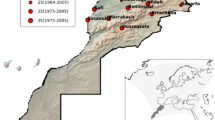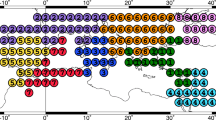Abstract
Global Climate Models (GCMs) are globally accepted simulations used for modeling and forecasting of precipitation and other parameters of climate. However, discrepancies among GCMs reduce the scope of individual models. In this regard, a multimodel ensemble provides a more accurate picture than individual models. However, the presence of extreme values and outliers in GCMs makes ensemble inappropriate for statistical analysis and reanalysis. In this article, we propose a novel weighting scheme that integrates the Exponentially Weighted Moving Average (EWMA) chart to obtain optimum weights for ensemble means of multiple GCMs – EWMA-based Ensemble (EWMABE). To investigate the validity of EWMABE, we used precipitation data of eighteen GCMs from the Coupled Model Intercomparison Project Phase 6 (CMIP6). In this study, the performance of EWMABE is compared with Multi-Model Simple Averaging Ensemble (MMSAE). The comparative statistics show that the EWMABE scheme has significantly improved the multimodel estimates. These results suggests the potential candidacy of EWMABE for the estimation of multimodel ensemble.







Similar content being viewed by others
Availability of Data and Materials
The data that support the findings of this study are available from the corresponding author upon reasonable request.
References
Ahmad M, Ali Z, Ilyas M, Mohsin M, Niaz R (2023) A common factor analysis based data mining procedure for effective assessment of 21st century drought under multiple global climate models. Water Resour Manage 37(12):4787–4806
Ahmed K, Sachindra DA, Shahid S, Demirel MC, Chung ES (2019) Selection of multi-model ensemble of general circulation models for the simulation of precipitation and maximum and minimum temperature based on spatial assessment metrics. Hydrol Earth Syst Sci 23(11):4803–4824
Ali Z, Qamar S, Khan N, Faisal M, Sammen SS (2023) A new regional drought index under x-bar chart based weighting scheme-the quality boosted regional drought index (QBRDI). Water Resour Manage 37(5):1895–1911
Ali F, Li BZ, Ali Z (2022) A new weighting scheme for diminishing the effect of extreme values in regional drought analysis. Water Resour Manage 36(11):4099–4114
Almazroui M, Saeed S, Saeed F, Islam MN, Ismail M (2020) Projections of precipitation and temperature over the South Asian countries in CMIP6. Earth Syst Environ 4(2):297–320
Baseer A, Ali Z, Ilyas M, Yousaf M(2023) A new Monte Carlo Feature Selection (MCFS) algorithm-based weighting scheme for multi-model ensemble of precipitation.Theor Appl Climatol1–12
Brekke LD (2009) Climate change and water resources management: A federal perspective. Diane Publishing
Chen R, Duan K, Shang W, Shi P, Meng Y, Zhang Z (2022) Increase in seasonal precipitation over the Tibetan Plateau in the 21st century projected using CMIP6 models. Atmos Res 277
Chhin R, Yoden S (2018) Ranking CMIP5 GCMs for model ensemble selection on regional scale: case study of the Indochina Region. J Geophys Res Atmospheres 123(17):8949–8974
De la Torre-Gutiérrez H, Pham D (2019) A control chart pattern recognition system for feedback-control processes. Expert Syst Appl 138:112826
Dong Z, Brahney J, Kang S, Elser J, Wei T, Jiao X, Shao Y (2020) Aeolian dust transport, cycle and influences in high-elevation cryosphere of the Tibetan Plateau region: New evidences from alpine snow and ice. Earth Sci Rev 211
Fan M, Lu D, Rastogi D, Pierce EM (2022) A spatiotemporal-aware weighting scheme for improving climate model ensemble predictions. J Mach Learn Model Comput 3(4):103408
García-Bustos S, Aparisi F, Epprecht EK (2015) Optimal EWMA of linear combination of Poisson variables for multivariate statistical process control. Int J Prod Res 53(14):4141–4159
Gebresellase SH, Wu Z, Xu H, Wada IM (2022) Evaluation of CMIP6 Climate Models for Climate Change Impact Assessments in Upper Awash Basin, Ethiopia
Guo H, Bao A, Chen T, Zheng G, Wang Y, Jiang L, De Maeyer P (2021) Assessment of CMIP6 in simulating precipitation over arid Central Asia. Atmos Res 252:105451
Hawkins DM, Olwell DH (1998) Cumulative sum charts and charting for quality improvement. Springer Science & Business Media
Jose DM, Vincent AM, Dwarakish GS (2022) Improving multiple model ensemble predictions of daily precipitation and temperature through machine learning techniques. Sci Rep 12(1):1–25
Kawase H, Imada Y, Sasaki H, Nakaegawa T, Murata A, Nosaka M, Takayabu I (2019) Contribution of historical global warming to local-scale heavy precipitation in western Japan estimated by large ensemble high-resolution simulations. J Geophys Res Atmos 124(12):6093–6103
Kulinich M, Fan Y, Penev S, Evans JP, Olson R (2021) A Markov chain method for weighting climate model ensembles. Geoscientific Model Development 14(6):3539–3551
Li T, Jiang Z, Le Treut H, Li L, Zhao L, Ge L (2021) Machine learning to optimize climate projection over China with multi-model ensemble simulations. Environ Res Lett 16(9):094028
Li Z, Qiu P (2014) Statistical process control using a dynamic sampling scheme. Technometrics 56(3):325–335
Li X, Fang G, Wei J, Arnault J, Laux P, Wen X, Kunstmann H (2023) Evaluation and projection of precipitation and temperature in a coastal climatic transitional zone in China based on CMIP6 GCMs.Climate Dynam1–23
Li P, Pereira PAR, Navas H (Eds.) (2021) Quality Control: Intelligent Manufacturing, Robust Design and Charts. BoD–Books on Demand
Lu K, Arshad M, Ma X, Ullah I, Wang J, Shao W (2022) Evaluating observed and future spatiotemporal changes in precipitation and temperature across China based on CMIP6‐GCMs.Int J Climatol
Mahmood T, Iqbal A, Abbasi SA, Amin M (2022) Efficient GLM-based control charts for Poisson processes. Qual Reliab Eng Int 38(1):389–404
Meresa H, Tischbein B, Mekonnen T (2022) Climate change impact on extreme precipitation and peak flood magnitude and frequency: Observations from CMIP6 and hydrological models. Nat Hazards 111(3):2649–2679
McFarlane N (2011) Parameterizations: representing key processes in climate models without resolving them. Wiley Interdisciplinary Rev Climate Change 2(4):482–497
Messner F, Meyer V (2006) Flood damage, vulnerability and risk perception–challenges for flood damage research. InFlood risk management: hazards, vulnerability and mitigation measures(pp. 149–167). Springer, Dordrecht
Ombadi M, Nguyen P, Sorooshian S, Hsu KL (2021) Retrospective analysis and Bayesian model averaging of CMIP6 precipitation in the Nile River Basin. J Hydrometeorol 22(1):217–229
Poddar A, Kumar A, Kashyap V, Thapa S (2022) Data-driven modeling approach in model rainfall-runoff for a mountainous catchment. In Modeling and Simulation of Environmental Systems(pp. 253–268). CRC Press
Qiu P (2013) Introduction to statistical process control. CRC Press
Raju KS, Kumar DN (2020) Review of approaches for selection and ensembling of GCMs. J Climate Change 11(3):577–599
Rhymee H, Shams S, Ratnayake U, Rahman EKA (2022) Comparing statistical downscaling and arithmetic mean in simulating CMIP6 multi-model ensemble over Brunei. Hydrology 9(9):161
Riaz M, Abbasi SA, Abid M, Hamzat AK (2020) A new HWMA dispersion control chart with an application to wind farm data. Mathematics 8(12):2136
Roberts SW (1959) Control chart tests based on geometric moving averages. Technometrics 1:239–250
Şentürk S, Erginel N, Kaya İ, Kahraman C (2014) Fuzzy exponentially weighted moving average control chart for univariate data with a real case application. Appl Soft Comput 22:1–10
Shewhart WA (1931) Economic Control of Quality of Manufactured Product. Van Nostrand Company, Princeton, N.J
Shiru MS, Chung ES (2021) Performance evaluation of CMIP6 global climate models for selecting models for climate projection over Nigeria. Theoret Appl Climatol 146(1):599–615
Song YH, Chung ES, Shiru MS (2020) Uncertainty analysis of monthly precipitation in GCMs using multiple bias correction methods under different RCPs. Sustainability 12(18):7508
Spiridonov V, Ćurić M (2021) Meteorological hazards. In Fundamentals of Meteorology(pp. 303–314). Springer, Cham
Wang HM, Chen J, Xu CY, Chen H, Guo S, Xie P, Li X (2019) Does the weighting of climate simulations result in a better quantification of hydrological impacts? Hydrol Earth Syst Sci 23(10):4033–4050
Wang L, Zhang J, Shu Z, Wang Y, Bao Z, Liu C, Zhou X, Wang G (2021) Evaluation of the ability of CMIP6 global climate models to simulate precipitation in the Yellow River Basin, China.Front Earth Sci 9:751974
Wilson J (2021) Two exploratory uses for general circulation models in climate science. Perspect Sci 29(4):493–509
Yousaf M, Ali Z, Mohsin M, Ilyas M, Shakeel M (2023) Development of a new hybrid ensemble method for accurate characterization of future drought using multiple global climate models.Stochastic Environ Res Risk Assess1–21
Zhang X, Hao Z, Singh VP, Zhang Y, Feng S, Xu Y, Hao F (2022) Drought propagation under global warming: Characteristics, approaches, processes, and controlling factors. Sci Total Environ 838:156021
Funding
The current research is a part of a funded research project awarded by the University of the Punjab Lahore, Pakistan (2022). Therefore, the authors are thankful to the project awarding institution.
Author information
Authors and Affiliations
Contributions
Muhammad Shakeel and Zulfiqar Ali conceived the presented idea. Muhammad Shakeel developed the theory and performed the computations. Zulfiqar Ali verified the analytical methods and computations. Both the authors discussed the results and contributed to the final manuscript.
Corresponding author
Ethics declarations
Ethical Approval
Not Applicable.
Consent to Participate
Not Applicable.
Consent to Publish
Not Applicable.
Competing Interests
The authors declare no competing interests.
Additional information
Publisher's Note
Springer Nature remains neutral with regard to jurisdictional claims in published maps and institutional affiliations.
Rights and permissions
Springer Nature or its licensor (e.g. a society or other partner) holds exclusive rights to this article under a publishing agreement with the author(s) or other rightsholder(s); author self-archiving of the accepted manuscript version of this article is solely governed by the terms of such publishing agreement and applicable law.
About this article
Cite this article
Shakeel, M., Ali, Z. Integration of Exponential Weighted Moving Average Chart in Ensemble of Precipitation of Multiple Global Climate Models (GCMs). Water Resour Manage 38, 935–949 (2024). https://doi.org/10.1007/s11269-023-03702-x
Received:
Accepted:
Published:
Issue Date:
DOI: https://doi.org/10.1007/s11269-023-03702-x




